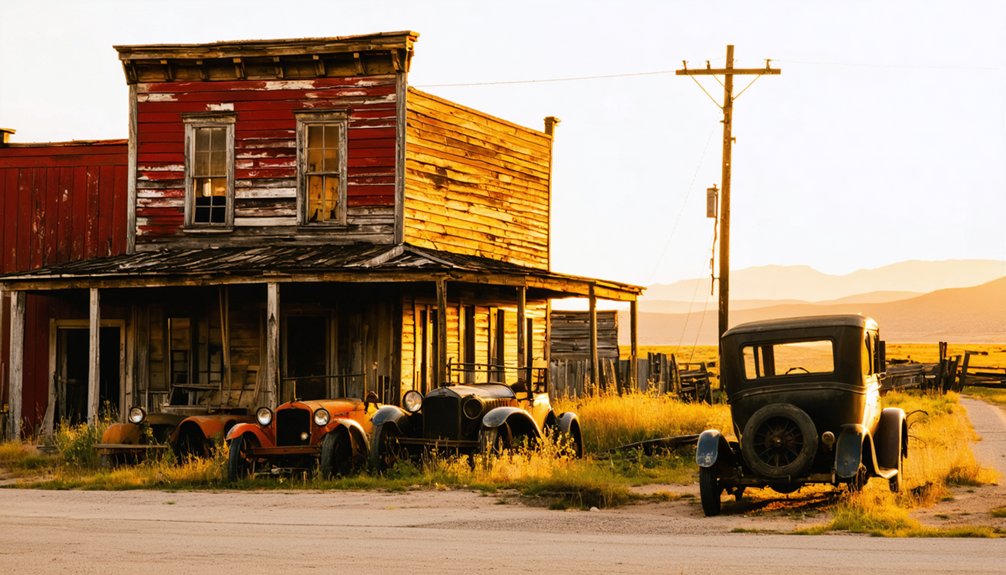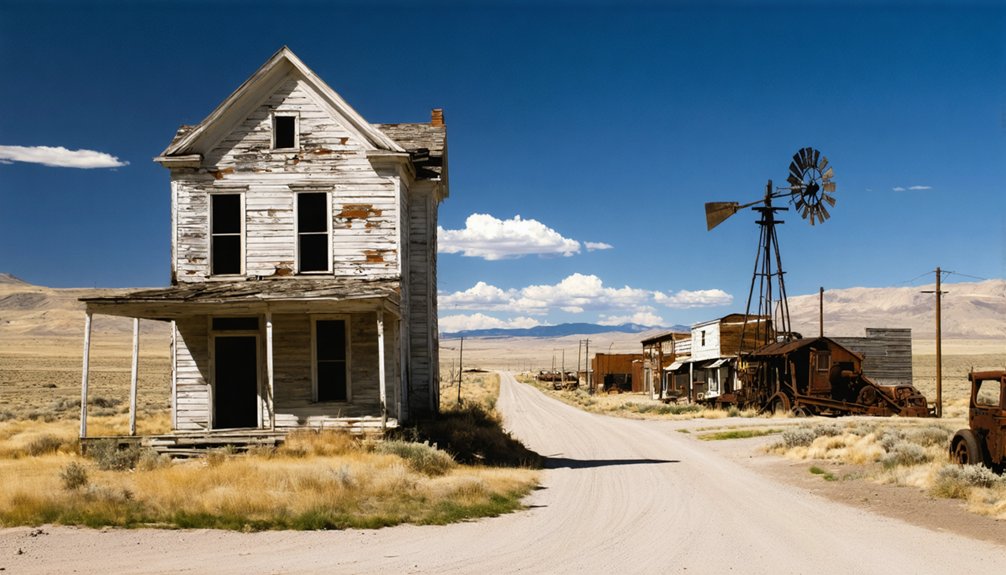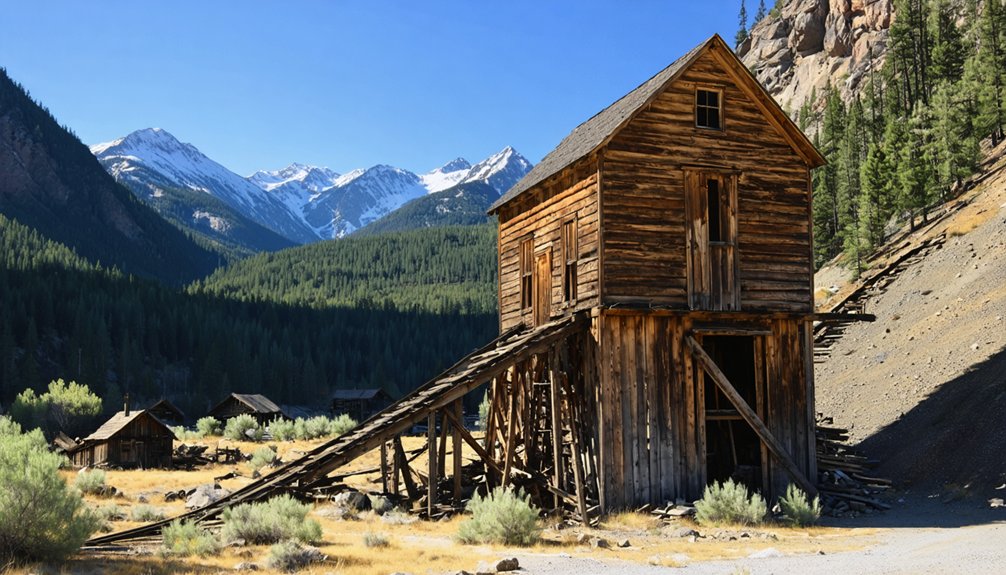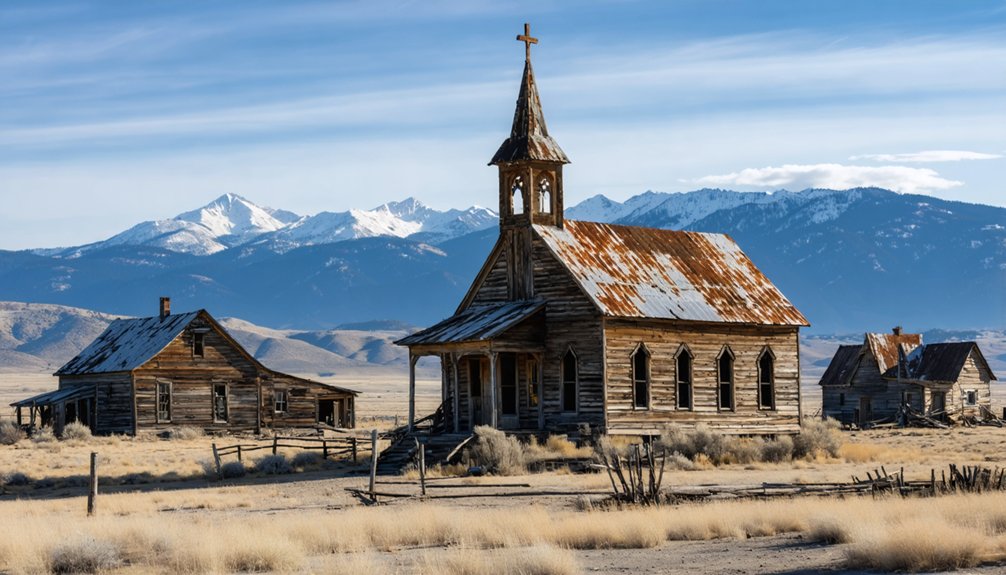You’ll find Pearl Valley Ghost Town nestled in the rugged terrain of Gem County, Idaho, where a late 19th-century gold rush transformed a single cabin into a bustling mining community of 243 residents. The town once boasted three mercantile stores, four saloons, two hotels, and thriving gold mines before its decline in 1910-1911. Today, you can explore weathered remnants and rusting machinery that tell fascinating stories of Idaho’s mining era, though you’ll need to navigate scenic backroads to uncover its secrets.
Key Takeaways
- Pearl Valley emerged as a gold mining boomtown in late 19th century Idaho, growing from one cabin to 243 residents by 1900.
- The town featured multiple businesses including stores, saloons, hotels, and a church during its peak mining years.
- Diamond and Checkmate mines were the primary economic drivers until operations ceased between 1910-1911 due to depleted ore deposits.
- The town experienced mass exodus after mining operations ended, with brief revival attempts during cobalt mining from 1949-1959.
- Today, Pearl Valley stands as a ghost town with weathered remnants and rusting machinery requiring careful navigation of scenic backroads.
The Discovery of Pear Valley
While Idaho’s mining history is rich with discoveries, Pearl emerged as a significant find during the late 19th century in what would become Gem County.
You’ll find that prospectors were drawn to the area’s abundant placer and lode gold deposits, establishing claims that would shape the region’s historical significance.
The town quickly grew beyond a simple mining camp, developing into a thriving community with mercantile stores, saloons, hotels, and a church.
Like the toll road to Challis built in 1879, Pearl’s infrastructure helped connect the community to other settlements in the region.
The Diamond and Checkmate mines drove Pearl’s cultural impact, attracting settlers and workers who built a bustling commercial center.
Early documentation from newspapers and historical societies reveals a dynamic community hosting social events and mining strikes.
The Stage Line to Pearl, advertised in 1897, provided crucial transportation for the growing mining town.
Though much of the original infrastructure now lies in ruins, Pearl’s discovery marked a pivotal chapter in Idaho’s mining heritage.
Mining Operations and Early Settlement
You’ll find that Pearl Valley’s earliest miners relied heavily on basic tools like mortars and horse arrastras before upgrading to small mills and concentrators in the mid-1890s.
The transition from simple tools to more complex operations mirrored the broader shift from placer to lode mining across Idaho’s mineral districts.
The miners worked steadily at established operations like the Checkmate, Lincoln, and Kentuck mines, making regular ore shipments every third day through Emmett and Nampa despite challenging road conditions.
What began as a single cabin in 1894 quickly grew into a bustling mining settlement as successful operations drew more workers and their families to the area, spurred on by the encouragement of local cowboys. By 1900, the town had grown substantially to include 243 total residents, with a mix of miners, merchants and their families calling Pearl home.
Early Mining Equipment Used
The primitive mining tools of Pearl Valley reflected the harsh realities of 1870s frontier extraction. You’d find miners wielding pickaxes, shovels, and hand drills in their daily battle against unyielding rock. These basic excavation methods, while effective, demanded immense physical toll as men worked deep within confined shafts reaching 600 feet below ground. The devastating natural disasters and floods that plagued many Idaho mining towns often destroyed equipment and halted operations for weeks.
Hand-powered drills and hammers broke through resistant ore bodies, with dynamite and nitroglycerine providing the explosive force needed for larger extractions.
Early miners along Gold Fork Creek established some of the area’s first mineral claims, setting the foundation for future mining operations.
Sluice boxes and pans lined the creeks, where prospectors used gravity and water flow to separate precious gold from worthless sediment.
VanWyck’s first blacksmith shop served as a vital hub, maintaining and fabricating the essential mining tools that kept operations running.
Miners’ Daily Work Life
Mining life in Pearl Valley transformed dramatically after the 1894 gold discovery, when Dan Levan’s promising panning sites sparked an expansion from basic hand mortars to more sophisticated horse-drawn arrastras.
You’d find miners’ routines centered around the daily grind of prospecting, digging, and crushing ore. The labor challenges were significant, as you’d have to haul ore and bullion all the way to Boise for processing – at least until the Idaho Northern Railway reached Emmett.
After that, shipping became more efficient, with mines like the Checkmate sending out a carload every three days through Emmett and Nampa. Your work would’ve involved constant equipment maintenance and ore processing, with early concentrators improving recovery rates.
The mining camp’s growth from a single cabin to a bustling operation reflected the increasing sophistication of daily operations. The mining operations proved profitable early on, generating $30,000 in gold during their first year of operation.
Settlement Growth Patterns
After Dan Levan’s initial gold discovery in 1894, Pearl Valley’s transformation from a solitary cabin beneath cottonwood trees into a bustling mining settlement began to take shape.
The community dynamics evolved as prospectors and miners flocked to the area, drawn by reports of rich gold yields reaching $30,000 in the first year alone.
Resource management became vital as the settlement expanded around:
- Strategic water sources and ore outcrops
- Small-scale milling operations near the Checkmate, Lincoln, and Kentuck mines
- Service structures supporting miners and their families
You’ll find that the town’s growth followed the classic Western mining pattern – rapid expansion during peak production years from 1894 to 1908, followed by gradual contraction as ore yields declined and mining operations became less profitable.
Daily Life in a Frontier Mining Town
Life in Pear Valley’s frontier mining settlement revolved around stark gender divisions that shaped daily routines and social interactions.
If you were a woman, you’d spend your days tackling endless domestic responsibilities: cooking hearty pre-dawn breakfasts, cleaning chamber pots, maintaining kerosene lamps, and educating children at home. Social isolation defined your existence, with few chances to visit neighbors or build meaningful connections. The rare opportunity for socializing came during seasonal berry harvesting. With limited housing options, families often lived in crude tents and log shacks hastily constructed near the mines.
Meanwhile, men’s experiences differed dramatically. You’d head to the mines each morning, sharing brief conversations with fellow workers during breaks.
After your shift, you’d likely join others at the saloon, where informal networks formed and news spread. While the work was dangerous and physically demanding, you’d find camaraderie that wasn’t available to the women confined to their domestic spheres.
The Peak Years of Prosperity

The bustling community of Pearl, Idaho reached its zenith during the late 19th and early 20th centuries, as rich gold and silver deposits transformed this frontier outpost into a thriving hub of commerce.
The social dynamics reflected a spirit of opportunity, with miners, merchants, and families establishing deep community ties through the town’s multiple businesses and gathering spots. Today, the area retains only a few active mines in operation.
In Pearl, people from all walks of life forged lasting bonds through shared spaces and commercial ventures, creating a vibrant frontier society.
- Diamond and Checkmate mines drove employment, attracting a substantial workforce that shaped Pearl’s community resilience.
- You’d find 3 mercantile stores, 4 saloons, 2 hotels, a butcher shop, and a church serving the growing population.
- The town’s strategic location near Boise made it the closest active mining community to the capital, fueling its economic success.
Pearl’s prosperity created a self-sustaining ecosystem where commerce and community flourished together, despite the inherent challenges of frontier life.
Natural Resources and Economic Impact
Rich deposits of lead, zinc, gold, and silver defined Pearl’s economic foundation, making it a pivotal mining center in Idaho’s mineral industry.
You’ll find that mineral extraction drove the town’s development, creating jobs and attracting workers who built their lives around the mines. The industry’s success funded essential infrastructure, from roads to housing, establishing Pearl’s economic sustainability.
However, you’d notice the geological challenges that miners faced, as overlying rock formations created stability issues in the mines.
While the operations generated tax revenue and supported local growth, they’ve left a complex environmental legacy. Today, Pearl’s designation as a U.S. Superfund site reflects the true cost of its mining heritage, though the area’s private ownership now limits access to these historical extraction sites.
The Decline and Abandonment

You’ll find Pearl’s mining operations came to an abrupt halt between 1910-1911 when the ore deposits were fully depleted.
The sudden economic collapse triggered a mass exodus, with miners and their families relocating to more prosperous towns like Custer and Bonanza in search of work.
The town’s population dwindled rapidly, leaving behind abandoned mines and empty buildings that would later be bulldozed, save for a single mine entrance that remains visible today.
Mining Operations Halt
After experiencing peak production from 1894 to 1908, mining operations at Pearl Valley began a steady decline marked by financial turmoil and dwindling yields.
You’ll find that mining technology couldn’t overcome the challenges of sinking mines and settling rock, while labor disputes complicated operations further. The once-profitable ventures that yielded up to $80,000 in gold by 1896 couldn’t sustain their momentum.
- The Lincoln Mine entered receivership after 1908, triggering a cascade of financial troubles
- Environmental concerns arose from toxic mineral weathering, including arsenic exposure
- Despite brief revivals for cobalt mining from 1949-1959, operations never regained stability
Population Exodus Timeline
The cascading effects of Pearl Valley’s mining decline brought sweeping changes to the town’s population between 1894 and the late 1900s.
You’ll find that population trends began shifting after 1910, as the once-bustling mining community faced dwindling ore reserves and reduced mining output. While the town maintained operations through the early 1900s, demographic shifts accelerated as younger residents sought opportunities elsewhere, particularly in nearby Boise.
The 1941 miners’ strike marked a significant turning point, highlighting the economic struggles that would further drive exodus from the area.
Exploring the Ghost Town Today
While Pearl’s mining heyday has long passed, today’s visitors will find a haunting collection of weathered remnants scattered across Idaho’s rugged landscape. The ghost town photography opportunities are limited, as most structures have been bulldozed, but you’ll discover rusting machinery and vintage cars that make compelling subjects against the scenic backdrop.
Weathered remnants and rusting machinery haunt Pearl’s landscape, telling silent stories of Idaho’s bygone mining era.
- Access requires traversing scenic backroads, with some areas restricted due to private ownership.
- Winter conditions can make travel challenging, so plan your exploration during warmer months.
- Watch for hazards like unstable mine shafts and contaminated areas.
You’ll need to exercise caution while searching for historical artifacts, as many areas are privately owned.
The town’s proximity to Boise makes it accessible for day trips, though there aren’t any formal tourist facilities to support your visit.
Preserving Idaho’s Mining Heritage

Preserving Idaho’s rich mining heritage remains a top priority through coordinated efforts between local preservation groups and government agencies.
You’ll find organizations like the White Knob Historical Preservation Committee working tirelessly to stabilize historic structures near Mackay, including essential mining railroad trestles and tramway towers that tell the story of the Alder Creek Mining District.
Through partnerships with the Idaho Heritage Trust, National Park Service, and other federal agencies, you’re witnessing a dedicated push to protect these irreplaceable landmarks.
While facing challenges like the reclamation of 8,800 abandoned mines, Idaho’s preservation teams are implementing modern techniques to balance historic preservation with environmental safety.
You can explore these restored sites, which now serve as educational destinations that keep Idaho’s mining heritage alive for future generations.
Planning Your Visit to Pear Valley
Planning your visit to Pear Valley requires careful preparation due to its remote location and limited amenities. With no confirmed transportation options or lodging availability nearby, you’ll need to be self-sufficient during your exploration of this historic mining site.
Visiting Pear Valley demands thorough planning – pack well and prepare to be self-reliant in this isolated historic mining region.
Before heading out, consider these essential preparations:
- Pack plenty of water, food, and emergency supplies, as there are no services in the immediate area.
- Research weather conditions and bring appropriate gear for Idaho’s variable climate.
- Bring navigation tools and a detailed map, since cell service may be unreliable.
While exploring the ghost town, respect any private property boundaries and watch for hazards like abandoned mine structures.
The area offers excellent opportunities for photography and hiking, but stay alert for wildlife encounters and challenging terrain.
Frequently Asked Questions
What Indigenous Tribes Originally Inhabited the Pear Valley Area?
Your ancestral lands of Pear Valley were home to the proud Shoshone and Bannock Native tribes, with the Tukudika (Sheep Eater) Shoshone band seasonally inhabiting nearby mountain regions of historical significance.
Were There Any Major Epidemics or Health Crises in Pear Valley?
You won’t find documented evidence of major epidemic outbreaks or health crises in Pearl Valley, though typical mining hazards like accidents and respiratory diseases affected workers in the area’s harsh conditions.
What Role Did Women and Children Play in Pear Valley?
You’ll find women’s roles centered on managing households and organizing social events, while children’s contributions included helping with chores. Together, they made up roughly 40% of the mining town’s population.
Were There Any Notable Crimes or Lawless Incidents in Pear Valley?
You won’t find many documented crime incidents in historical records – there’s no evidence of significant lawlessness or notable law enforcement activity beyond a 1941 miners’ strike involving 65 workers.
What Transportation Methods Were Used to Reach Pear Valley During Its Peak?
You’d have reached the area via stagecoach routes connecting to railroad access points, while pack trains and mule teams handled supplies through rugged terrain before modern roads developed.
References
- https://pinintheatlas.com/travel-blogs/ghost-towns-of-idaho/
- https://history.idaho.gov/wp-content/uploads/2018/08/0064.pdf
- https://en.wikipedia.org/wiki/List_of_ghost_towns_in_Idaho
- https://dustywindshield.wordpress.com/2017/12/05/ghost-towns-in-the-upper-clearwater-river-corridor-region/
- https://www.gemcountymuseum.org/history-Pearl-index.html
- https://visitidaho.org/things-to-do/ghost-towns-mining-history/
- https://westernmininghistory.com/towns/idaho/pearl/
- https://scholarworks.boisestate.edu/cgi/viewcontent.cgi?filename=7&article=1480&context=fac_books&type=additional
- https://www.ghosttowns.com/states/id/pearl.html
- https://www.youtube.com/shorts/wi7D-a-x1Ts



